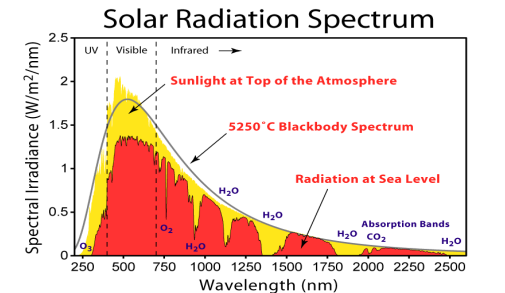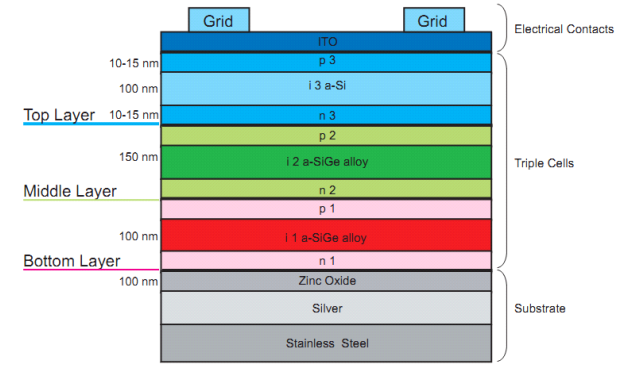Technologies The concentrated solar power generation technologies could be generically divided into two big categories: Concentrated Solar Photovoltaics (CSPV) and Concentrated Solar Thermal Power (CSTP) generation. We can use the photovoltaic effect to directly convert sunlight into direct current electricity. PV system uses photovoltaic materials to absorb the sunlight which comprises photons with different wavelengths (Fig 1.1). Photons with more than the band gap energy can excite electrons in the photovoltaic material to jump out of the band gap and attain a free electron. Based on Detailed Balance Limit, single junction solar cell has a highest conversion efficiency of 30.8% under one sun radiation. With maximum concentration of sunlight on earth, this efficiency can rise up to 40.8%. It is proven that sunlight concentration could increase solar cell efficiency and reduce cost/efficiency ratio.

Multijunction solar cell technologies can absorb more photons of different wavelength and perform best with concentrated sunlight. Triple junction solar cells are designed as a three layer sandwich. Spectrum splitting of solar photodiodes is the key to a higher energy output. The top layer, which captures blue photons, uses amorphous silicon (A-SI) with an optical band gap of 1.8 eV (electron volt) for the intrinsic layer. The middle layer is amorphous silicon-germanium (a-SiGe) alloy with about 10-15% Ge, with optical band gap of 1.6 eV, which is ideally suited for absorbing green photons. The bottom layer captures red and infrared photons using a layer of a-SiGe alloy with about 40-50% Ge, with an optical gap of -1.4eV. Light rays not absorbed during the entry would be reflected from the silver /zinc oxide (Ag/ZnO) metal layer and then be absorbed on the way out. Fig 1.2 shows the detailed structure of a common triple junction solar cell.
Multi-junction solar cell architectures are capable of up to 70% theoretical efficiency limit, and up to 50% efficiency in practice. It can convert twice as much of the sunlight converting into electricity than flat panel silicon cells. Currently, there are several suppliers for solar cells. The most widely used is from Spectrolab – a division of Boeing and a company that set records for the solar cell efficiency. Other companies include Emcore, Azur Space and JDSU. Solar Junction is a new player in this industry and has received a lot of attention for its lattice matched solar cell architecture that provides material band gap tenability to maximize the absorbed sunlight.

The technology of producing triple-junction cells with more than 40% conversion efficiency under field operating conditions is already mature. Although triple junction cells are more difficult to manufacture than silicon cells and cost much more per unit area, the triple junction solar cells cost much less in terms of per unit solar powered generator through the use of solar concentrators. And if you want to explore the more technologies of solar powered generate, you can buy a generator from solar generator manufacture, now its price are inexpensive with variable products to choose.
